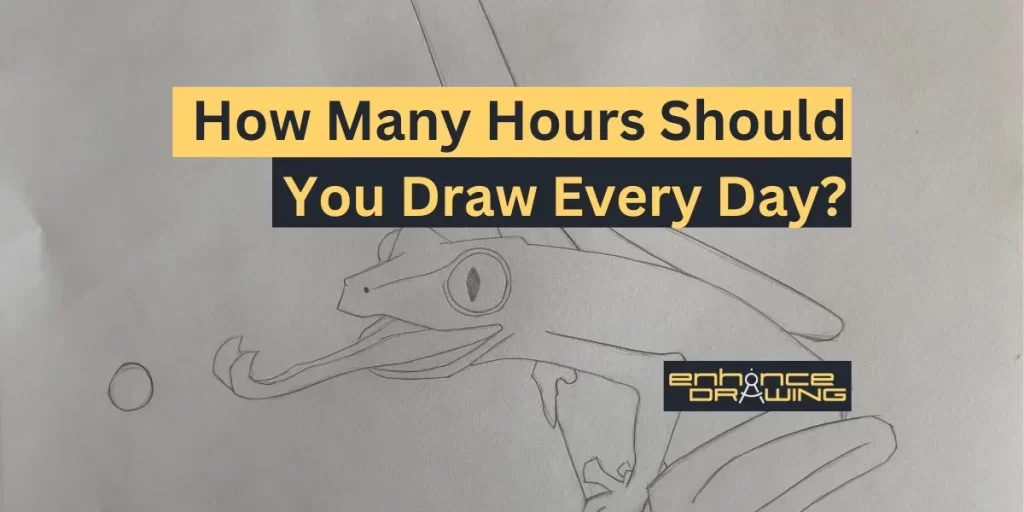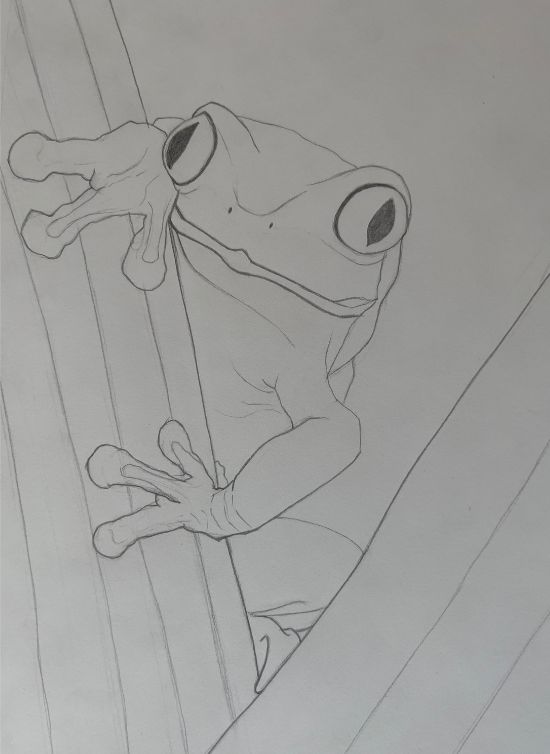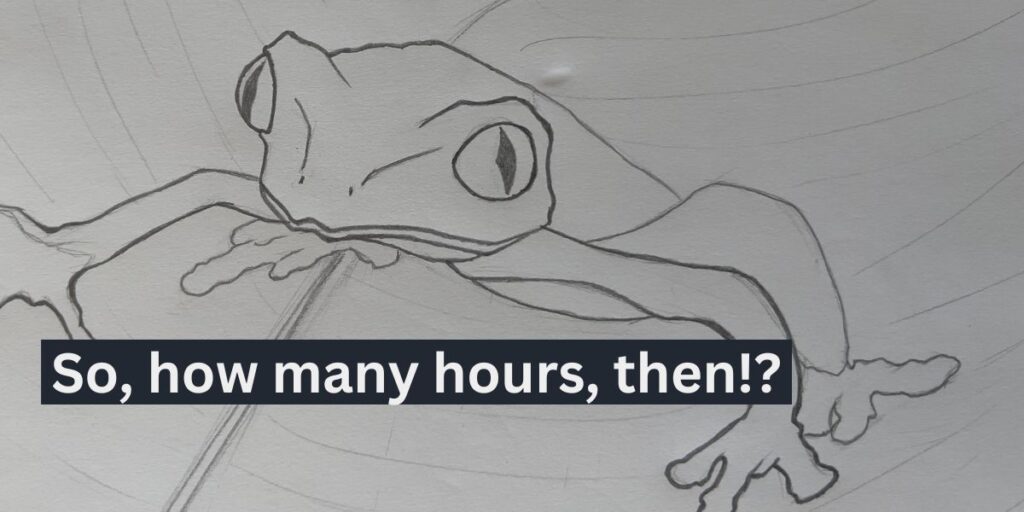
At a point in our artistic journey, we start to take drawing more seriously. We realize we love to draw! And we want to get better at it, so we ask ourselves: how much should I draw every day?
As a general rule, you should draw for at least 2-4 hours a day. Drawing for more than 5-6 hours will help you see improvements faster, but stretching and including physical activities in prolonged drawing routines is essential.
That is a general answer, and it could only work for some, so I created a chart to address different scenarios for you to find your ideal drawing routine. And most importantly, you will learn how to make that time as effective and enjoyable as possible. (And see a bunch of random red-eyed tree frogs I decided to study while writing this blog)
How Much Should You Draw a Day?

I know you would love to hear there is a scientific group that made a study about the exact amount of hours anybody should draw a day to get better at it, but the thing is that what works for some people doesn’t work very well for others, or it just doesn’t work at all.
But for a general answer, drawing for 3-4 hours a day will be enough. This is the number of hours most people can draw every day and be consistent. You will improve very fast. If you have a lot of time, energy, and drawing for long periods every day doesn’t drain you, 5-6 hours a day would be much more than enough.
(Should’ve given this frog an extra hour to fix the proportions)
However, what if your life responsibilities, schedule, general stamina, and countless other factors don’t let you draw for 5-6 hours daily? Should you then abandon drawing? Should you resign to never being able to become a better artist because you can only draw 1-3 hours a day? The short answer is no. You can become a fantastic artist even if you only practice for an hour a day or even an hour every two days; it will just take a little longer.
Drawing for any amount of time a day will make you improve at it. One hour is better than zero hours, so if you find here or anywhere else that you need to draw for “x” hours a day and don’t have that time because of your schedule, lifestyle, etc., simply draw as much as you can. I’ve seen hundreds of artists with super busy lives getting better at drawing with just one hour of daily practice, even if they missed some days.
Tip: Instead of seeing things as daily practice hours, you can see them as weekly or monthly. One hour a day doesn’t sound as much time, and it feels like no one can significantly improve at anything in just an hour, but if you reframe how you see it, you’re practicing 7 hours a week and 30 hours a month: do you think 7 or 30 hours of deliberate practice will make you improve at drawing?
So now you see where we’re going with this: consistency is the secret sauce behind getting better at drawing. And, of course, if you can consistently draw for 4 hours a day, your drawing skill level will increase much faster.
But I promised to help you determine your ideal daily drawing routine, so I made up a list of questions to help you understand your relationship with drawing and find a plan that works for you.
How Many Hours a Day Should I Put Into Drawing?
Finding the ideal number of hours you should draw daily requires some digging. Please answer these questions to yourself and compare them to the graphic below to determine your plan.
1) What’s the longest time you have drawn with very short breaks or none at all?
- a) One to three hours.
- b) Four hours or more
2) How did you feel after drawing for that time?
- a) Energized, ready for more.
- b) Satisfied, happy, wouldn’t draw more or less.
- c) Drained, frustrated, or bored, not wanting to draw anymore.

3) How many days in a row have you been able to draw for that time?
- a) Less than a week
- b) More than a week
Note that your life, beliefs, and attitude toward drawing will change over time. Maybe you can only draw for an hour a day right now, but you will probably be able to draw for 4 hours at some point and enjoy it to the fullest. The ideal time you should draw heavily depends on you, so it’s important to reevaluate the hours you draw a day occasionally. The chart’s purpose is to guide you to find what works for you.
| AAA | Continue drawing the same hours you’re drawing and focus on consistency. |
| AAB | If you have the time, increase an hour more to your drawing routine and reevaluate in a week. |
| ABA | Draw less time until you can draw for more than a week in a row and reevaluate. |
| ABB | Don’t change anything, but if you can draw consistently for two weeks, try adding an hour and see how you feel. |
| ACA | Your current goal should be to improve your relationship with drawing. Try reading how to enjoy drawing. |
| ACB | Apart from improving your relationship with drawing, you could take a break, draw for fewer hours or start studying a subject you think will be fun. Try reading how to enjoy drawing. |
| BBB | You found your sweet spot, and I suggest keeping it as is. Try adding more hours, but pay close attention to your energy levels, mood, and how much you enjoy drawing. If you start to feel drained, go back to normal. |
| BAA | You have a roaring passion for drawing but probably need more structure. Focus on creating a habit of drawing and being consistent. Try reading how to make drawing a habit. |
| BAB | Don’t worry about how many hours you should draw; you’re already drawing more than enough! Keep on going, and you will achieve your artistic goals very fast! |
| BBA | Hours-wise, you’re good to go. Focus on consistency and a strong structure! Try reading how to make drawing a habit. |
| BCB | You’re probably drawing too much. Focus on your needs, cut some hours, take breaks, and come back strong. |
| BCA | Cut your hours to half and see if you can draw for over a week. Then reevaluate. |
I hope this chart helps you the same way it helped me and many other friends! I did it focusing on the hours you could potentially draw and be consistent at it, and I made it as simple to follow as possible so you can accommodate it to your case. Don’t use it to the extreme, be flexible; if you didn’t draw one day because you were on a trip, were sick, had an important event, wanted to take a day off consciously, etc., you didn’t miss a day. Again, the chart’s purpose is to guide you to find what works for you.
This question leads to many other concerns. Like, for instance, what if we don’t draw every day?
Is It Okay Not To Draw Every Day?

It is okay not to draw every day. You will improve and could be a successful artist without drawing daily. If you think about it, no single artist has drawn every day of their lives. Nor an athlete, chess player, video-game player, etc.; taking days off is entirely normal. In fact, taking days off is necessary in many cases.
So again, it is okay not to draw every day, but of course, you want to avoid falling into the habit of skipping drawing for weeks or months and start not to draw for longer than you draw.
I was listening to a podcast where Marshal Vandruff, an exceptional artist, said that the people he saw becoming great, successful artists were the ones that loved to draw because they would naturally spend more time drawing.
Tip: Enjoy your craft; enjoy drawing. Drawing is fantastic, and if you accept all the challenges it has and love the effort you put into it to improve, the natural consequence will be that you’ll be drawing more and get better at it without even realizing it.
I’m not saying, “Don’t draw every day,” I actually encourage you to do so and get as close as possible to draw daily, as it will help you become a better artist much faster. But it would be best if you didn’t stress so much that it would start interfering with your emotions and life. Strive to draw daily, but remember that it is okay to take breaks and that your skills will remain intact if you skip a couple of days or weeks. Even if you don’t draw for months, the only thing that will happen is that you’ll be a little rusty and usually get back to normal within a week.
Will I Improve If I Draw Everyday?
Although it is not strictly necessary, drawing every day will make you improve your art much faster than drawing occasionally. Drawing is a subject that requires a lot of time, so the more time you give to it, the more improvements you will see.
I like to see improvement in drawing this way: imagine you are a character in a video game. You are born with all your skills at level one, but you can practice them and level up. From level 1 to level 2, you’re required to practice the skill for an hour, and then from level 2 to three, you need to practice the skill for an hour and a half. If you only practice for an hour the next day, you will have half an hour left to reach level 3. The experience and time you put into practicing don’t disappear; it adds to your progress. In life, it’s not like we learn to swim or ride a bike and then forget it if we don’t do it for years. The skill remains there, maybe a little rusty, but still there.
There could be some cases in which you could feel like your drawings are getting worse even though you’re drawing every day, so I made a blog all about why your drawings are getting worse that can help you decode and fix what you could be doing wrong.
What I want you to see with this is that you will always improve whether you draw every day or not. I want to encourage you to draw every day because I know that will make you a better artist faster, but what’s more important is to enjoy drawing and drawing more. If you love to draw, drawing more often will be the natural consequence.
If you need more information about finding what’s ideal for you, I made a blog that helps you determine if you should draw every day or not.
If anything, drawing every day is a means for you to become a better artist faster. But how long does it take for you to get good at drawing anyway?
How Long Does It Take To Get Good At Drawing?
“Getting good” at anything is very subjective. Your definition of that could deviate a lot from my definition. However, if you’re following a drawing course or have an organized structure to study drawing, you can get pretty good at it in about two years. I have an entire article about how long it takes to learn to draw, in which I display numerous examples and provide various tips and plans to achieve your artistic goals asap.
Finally, I want to discuss the easiest way to naturally be able to draw every day. It becomes easier when you get there, but it is hard to get there. I’m talking about making drawing a habit.
Make Drawing A Habit
If you want to be able to draw every day, the ultimate goal is to make drawing a habit. We want drawing to be something we do every day without having any resistance against it. We know this is possible, and it will require a lot of conscious thought and actions to make drawing something unconscious.
To get started at this, you must get a pencil and a sketchbook that’s small enough to carry everywhere you go. Then, whenever you have the chance and remember drawing, you can start doodling, practicing things you’re studying, or sketching what’s in front of you. Think about all our idle time watching our phones while waiting for anything. Now think about all the chances you would have to draw in those same scenarios. All these little moments will add up to those daily hours of drawing you want to include on a daily basis.
Apart from that, you want to design and create a space to focus on drawing. This is the most important thing when it comes to making drawing a daily habit. I linked to an article all about this in the chart just in case you want to see it.
I hope this helps you define how many hours to draw a day, reach your goals faster, and understand your relationship with drawing.
